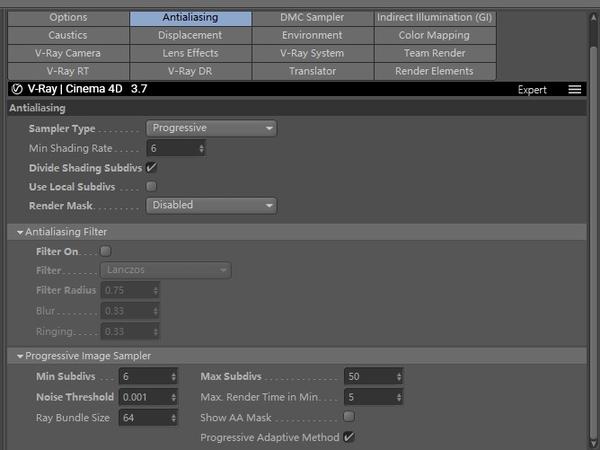

This is especially true for the Adaptive subdivision sampler, which stores all individual sub-samples taken within a bucket. Using large bucket sizes may take a lot of RAM. A note on RAM usage: image samplers require substantial amount of RAM to store information about each bucket.For complex scenes with lots of blurry effects and/or detailed textures, the Fixed ratesampler performs best and is very predictable with regards to the quality and render time.Also in the case of animations involving detailed textures, the Adaptive subdivision sampler might produce jittering which the Adaptive DMC sampler avoids. For images with detailed textures or lots of geometry detail and only a few blurry effects, the Adaptive DMC sampler performs best.For smooth scenes with only a few blurry effects and smooth textures, the Adaptive subdivision sampler with its ability to under sample the image is unbeatable.Which sampler to use for a given scene? The answer is best found with experiments, but here are some tips:.also i noted that images with good AA can be scaled up much better than “normal” 3d images, so it might pay to invest in learning the AA engine and use good quality settings. still high settings like 4x16x can be used at ultra high speeds for superb image quality. such extreme values wont be used all time, but they show the power behind. In vray you can use values like 100x AA with Adaptive DMC Sampling (with universal setting p.e.) and still get ok render times. i believe one aspect of the high image quality in vray is not only the great GI engine but also the wonderful AA quality. for areas that don`t need much antialiasing vray can use under sampling - negative values - at the same time, depending on the method, this highly adaptive AA can give ultra crisp and still still soft results at reasonable render times. Vray can render ultra fine lines, by oversampling an image in an intelligent and still fast way. also analog methods are not bound to pixels and therefore do not have to problem of pixel stepping when images do not have enough resolution or of very tiny and fine structures have to be rendered. those lenses and also the air filter the light and compensate extreme contrast between near points. Why do we need AA in renderings? - in real word cameras or in the human eye the light goes through more or less perfect lenses.


 0 kommentar(er)
0 kommentar(er)
